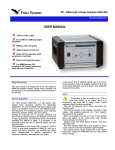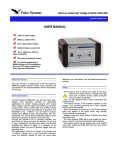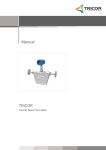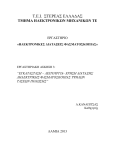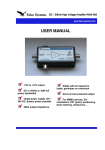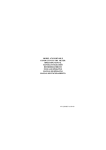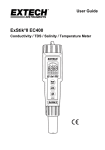Download USER MANUAL - Products4Engineers
Transcript
Falco Systems WMA-100 High Voltage Amplifier DC – 500kHz USER MANUAL ● High voltage: 20x amplification up to +175V and -175V output voltage with respect to ground ● DC to 500kHz at (-3dB) large signal bandwidth and 100mA output current ● Very low noise: ~350µVrms, and even lower when capacitive loads are driven ● No overshoot with capacitive loads: bandwidth changes automatically to ensure stability ● Short-circuit protected output ● Adjustable DC offset About this manual This user manual is an integral part of the Falco Systems WMA-100 high voltage amplifier product. Please read it carefully and pay attention to the recommendations and instructions for safe use. The WMA-100 high voltage amplifier: getting started The Falco Systems WMA-100 model is a high quality, cost-effective, high voltage, linear laboratory amplifier. Its wide bandwidth and large voltage range make it an excellent choice for use with MEMS devices, EO-modulators, piezo positioning systems, beam steering, ultrasonics, dielectric studies, and many other applications. It is designed to be fully stable and free of spurious signals with any capacitive load. The amplification is 20x (fixed). The amplifier has a range of –175V to +175V, a large signal bandwidth of 500kHz @ 3dB, a typical slew rate of 350V/µs, and a noise level of ~350µVrms. The short-circuit protection with a fast current limit of ±100mA make this amplifier suitable for both normal daily laboratory use and automated measurement systems. Recommendations: - Never apply more than +15V (-15V) to the amplifier input to prevent damage. - A short voltage spike may appear at the output, when the amplifier is turned on or off. Pay attention not to damage sensitive circuitry or equipment already connected. - The amplifier cannot be damaged by a short-circuit condition or capacitive loading, but two situations should be avoided: ● Connecting a charged capacitor to the input or output. ● Connecting a highly inductive load to the output (such as a coil). - Do not connect anything to the output that can act as an antenna. - This product should only be cleaned with a soft, slightly moist cloth. Unplug the WMA-100 amplifier from the mains power before cleaning. Safety - This product is able to produce over 175V at more than 100mA at its output, which is a very high level (risk of electric shock). Safety measures should be taken accordingly. This is indicated by the sign above the output connector of the amplifier. - This product is a Class I appliance which requires a mains connection with protective earth. - Always position the WMA-100 amplifier such that the on/off power switch is easily accessible. - The airflow to and from the WMA-100 amplifier should not be blocked or impeded, both at the front and the back side. - The internal circuitry of the amplifier operates at high voltage. Only qualified personnel from Falco Systems should service this amplifier. - Only replace fuses with the correct type: ● 230V version of the WMA-100: 250V 250mA 5x20mm slow blow. ● 115V version of the WMA-100: 250V 500mA 5x20mm slow blow. - The Falco Systems WMA-100 amplifier is only suitable for indoor use in a class II environment (domestic, light industrial). - Non-sinusoidal mains power generators cannot be used to power this product. Detailed properties of the WMA100 high voltage amplifier Input The input impedance of the WMA-100 high voltage amplifier is a 100kΩ resistor to ground, in parallel with 68pF to prevent electrostatic discharge (ESD) input damage. This resistor adds some noise to the output voltage unless a low-impedance source (e.g. a 50Ω output function generator) is connected to the input. The noise will be slightly higher when the amplifier input is left open. The 100kΩ resistor also adds to the output offset voltage because the offset current of the input amplifier generates a voltage over this resistor. This output offset voltage is ~10mV if the input is left open. When the input is shorted or connected to a low-impedance source, the offset is reduced to ~8mV. A high-speed amplifier like the WMA-100 model can never be made fully insensitive to input overload conditions, as this would limit the performance of the amplifier significantly. For normal operation, input voltages should remain in the –8.75V to +8.75V range, resulting, with an amplification of 20x, in an output voltage swing of –175V to +175V. Below -15V and above +15V, the input protection circuitry will limit the voltage fed to the amplifier, but the amplifier may be permanently damaged if the current of the source is not limited. Output The WMA-100 model has been designed to be fully stable with all capacitive loads. It has been optimized for a perfect stepresponse, but it is also a very good linear and sine-wave amplifier. The WMA-100 amplifier has a clever feedback system, which ensures that no significant overshoot occurs at any capacitive load. The bandwidth of the amplifier is automatically reduced to ensure stability. Instability under capacitive loading conditions is a common problem of other high-speed negative feedback amplifiers, often resulting in unwanted output overshoot voltages, and, in extreme cases, oscillations. Short-circuiting this amplifier will not break down the amplifier, due to the extremely fast current limiting circuit that has been employed. If output monitoring is required, it is recommended to connect a 10x oscilloscope probe to the output. A special BNC to probe tip connector is usually supplied with the probe (Fig. 1). However, the user can choose a different way of connecting the oscilloscope, as long as care is taken with the high output voltage. Using non-coaxial cable can cause overshoot in the oscilloscope reading. Figure 1. A 10x probe connected for monitoring the output signal Noise The noise of the amplifier (~350µVrms) is lowest when a low-impedance source is used, such as a pre-amplifier output or a 50Ω function generator output. An easy way to assess the noise performance of the amplifier without picking up interference is to connect a 50Ω coaxial load resistor to the input (Fig. 2) and monitoring noise voltage at the output with a sensitive amplifier. The output noise will be lower when the bandwidth of the amplifier is reduced, which happens when a significant capacitive load is connected to the output (see Fig. 16 for a detailed measured curve). Figure 2. If assessment of the amplifier noise is necessary, connect e.g. a 50Ω coaxial load resistor to the input to provide a low-impedance input connection. Offset adjustment The WMA-100 model provides an offset control knob to enable the amplifier to generate offset voltages over the full output range (Fig. 3). The offset control can be switched to ‘Off’ with a small rocker switch on the front panel to obtain the lowest noise and highest DC stability of the amplifier. Turning the offset control to ‘On’ enables the DC control knob. The DC offset voltage reacts to adjustments of this knob in a second. With the offset control turned to ‘On’, the noise performance of the amplifier becomes slightly higher: ~600µVrms instead of ~350µVrms. Figure 3. Offset circuitry ‘On-Off’ switch and offset control knob The load The output impedance of the WMA-100 model is 50Ω, to ensure stability with all capacitive loads. The amplifier is generally used for high-impedance applications where the load is capacitive. This is the case for MEMS devices, EO-modulators and piezo’s alike. It should be noted that a coaxial cable itself also presents a capacitive load of approximately 100pF/m. The cable that is connected may limit the maximum usable current at high frequencies. Matched loading with a 50Ω load circuit is possible by connecting a 50Ω resistor in series with the output to ground, but is not recommended. The advantage is that excessively long cables will not distort the waveforms. The disadvantage is a highly reduced voltage range (100mA in 50Ω gives 5V maximum instead of 175V maximum). With sensitive and/or high-frequency measurements, coaxial cables should be used for connecting both the input and the output, and its length should be minimized. Otherwise the cables will cause overshoot due to cable reflections (an effect related to the finite speed of light), and current limiting due to the cable capacitance. Although the amplifier itself remains fully stable, using less than 5 meter of output cable is recommended for the WMA-100 amplifier to obtain optimal results. Transmitter mode This amplifier can generate a significant amount of power at frequencies used for radio transmission and reception. The amplifier should not be used for telecommunication as described in the R&TTE directive 95/5/EC. Also for this reason always use coaxial cables. Amplifier characteristics In the following pages, several amplifier characteristics are illustrated: - Frequency response as a function of capacitive load (Fig. 4, 5) - Sine and triangle wave responses (Fig. 6, 7) - Square wave response (Fig. 8, 9, 10) - Step response (Fig. 11) - Capacitive load dependency of square wave output (Fig. 12) - Noise and offset with and without offset control engaged (Fig. 13, 14) - Noise spectrum (Fig. 15) - Rms output noise voltage versus capacitive load (Fig. 16) 0pF 100pF 1nF 10nF 100nF 1uF 10uF Amplification factor 20 15 10 5 0 2 3 10 4 10 5 10 6 10 10 7 10 Frequency (Hz) Figure 4. Frequency response at 300Vpp output voltage with different capacitive loads 0pF 100pF 1nF 10nF 100nF 1uF 10uF Amplification factor 20 15 10 5 0 2 3 10 4 10 5 10 6 10 10 7 10 Frequency (Hz) Figure 5. Frequency response at 1Vpp output voltage with different capacitive loads Output voltage (V) 150 100 50 0 -50 -100 -150 0.0 0.5 1.0 1.5 Time (ms) Figure 6. Sine wave 300Vpp 1kHz 2.0 Output voltage (V) 150 100 50 0 -50 -100 -150 0.0 0.5 1.0 1.5 2.0 Time (ms) Figure 7. Triangle wave 300Vpp 1kHz Output voltage (V) 150 100 50 0 -50 -100 -150 0.0 0.5 1.0 1.5 2.0 Time (ms) Figure 8. Square wave 300Vpp 1kHz Output voltage (V) 150 100 50 0 -50 -100 -150 0 5 10 15 Time (µs) Figure 9. Square wave 300Vpp 100kHz 20 Output voltage (V) 0.4 0.2 0.0 -0.2 -0.4 0 5 10 15 20 Time (µs) Figure 10. Square wave 1Vpp 100kHz (small signal response) Output voltage (V) 150 100 50 0 -50 -100 -150 0.0 0.5 1.0 1.5 2.0 2.5 3.0 Time (µs) Figure 11a. 300Vpp step response 10-90%: up in 1.0µs Output voltage (V) 150 100 50 0 -50 -100 -150 0.0 0.5 1.0 1.5 2.0 2.5 3.0 Time (µs) Figure 11b. 300Vpp step response 10-90%: down in 0.9µs 160 Output voltage (V) 140 120 100 80 60 40 20 0 0.0 0.5 1.0 1.5 2.0 2.5 3.0 Time (µs) Figure 11c. 0 to 150V step response 10-90%: up in 0.8µs 160 Output voltage (V) 140 120 100 80 60 40 20 0 0.0 0.5 1.0 1.5 2.0 2.5 3.0 Time (µs) Figure 11d. 150 - 0V step response 10-90%: down in 0.8µs Figure 11. Unipolar and bipolar step response Output voltage (V) 150 100 50 0 -50 -100 -150 0 5 10 Time (µs) Figure 12a. 0pF load 15 20 Output voltage (V) 150 100 50 0 -50 -100 -150 0 5 10 15 20 30 40 Time (µs) Figure 12b. 100pF load Output voltage (V) 150 100 50 0 -50 -100 -150 0 10 20 Time (µs) Figure 12c. 1nF load Output voltage (V) 150 100 50 0 -50 -100 -150 0 50 100 Time (µs) Figure 12d. 10nF load 150 200 150 Output voltage (V) 100 50 0 -50 -100 -150 0.0 0.5 1.0 1.5 2.0 15 20 Time (ms) Figure 12e. 100nF load Output voltage (V) 150 100 50 0 -50 -100 -150 0 5 10 Time (ms) Figure 12f. 1µF load Output voltage (V) 150 100 50 0 -50 -100 -150 0 50 100 150 200 Time (ms) Figure 12g. 10µF load Figure 12. 300Vpp square wave response under different capacitive loading conditions. The 100mA current limit limits the speed at which the capacitor can be charged. The bandwidth adjustments of the amplifier with different capacitive loads preventing overshoot are clearly visible. Note the difference of the horizontal timescale in the figures. Output voltage (mV) 12 10 8 6 4 2 0 0 10 20 30 40 50 Time (ms) Output voltage (mV) Figure 13. Noise (~350µVrms measured with a true rms voltmeter) and typical offset with the offset control switched to ‘Off’. The noise and offset may appear to be higher than shown here if the amplifier input is not connected to a low-impedance source. 4 2 0 -2 0 10 20 30 40 50 Time (ms) Output voltage noise density (dbmV) Figure 14. Noise (~600µVrms measured with a true rms voltmeter) with the offset control switched to ‘On’. In addition, the short term drift of the offset is around 5mV. -40 -50 -60 -70 -80 -90 10 3 10 4 5 10 10 6 10 7 Frequency (Hz) Figure 15. Noise spectrum (262144 bins 15MHz FFT) with offset control switched to ‘Off’. Rms output voltage noise (µV) 350 300 250 200 150 100 50 10 2 10 3 4 10 5 10 10 6 10 7 Capacitance (pF) Figure 16. Rms output noise voltage versus capacitive load with offset control switched to ‘Off’. Technical specifications Amplification: 20x, fixed Bandwidth: DC – 500kHz @ -3dB large signal bandwidth Slew rate: 350V/µs typical Output voltage: -175V to +175V Current: 100mA typical with limiter Noise and offset: 350µVrms output noise typical, 8mV offset typical Input impedance: 100kΩ Output impedance: 50Ω Stability: stable with all capacitive and resistive loads, no overshoot > 5% Power: 230V 50Hz AC, 50W or 115V 60 Hz AC, 50W Mains fuse: 2x 0.25A 250V slow blow (230V version) or 2x 0.5A 250V slow blow (115V version) Safety: Class I - requires mains power connector with protective earth Overvoltage: Category II Operating temperature: 15 – 30°C Storage temperature: 0 – 60°C Relative humidity: 30 – 70% non-condensing Maximum usage height: 2000m Dimensions: 52 x 165 x 220mm Weight: 2.5kg Country of origin: The Netherlands Specifications may be subject to change Harmonized standards WEEE and RoHS This product complies with the following harmonized European standards: Do not dispose of the WMA-100 amplifier as standard waste, but bring it to a WEEE electronic waste collection point. The amplifier has been built in compliance with the RoHS directive. Safety: EN61010-1 EMC: EN61326 Warranty Falco Systems products are guaranteed against malfunction due to defects in materials or workmanship for a period of 1 year from the date of shipment. If a malfunction occurs during this period, the product will be repaired or replaced without charge. The product will be returned to the customer prepaid. The warranty does not apply to: - Exterior finish or appearance - Malfunction resulting from use or operation of the product in other ways than specified in the user manual - Malfunctioning due to misuse or abuse of the product - Malfunctioning occurring after changes or repairs have been made by anyone other than Falco Systems. To obtain warranty service, the customer has to inform Falco Systems first via [email protected] to receive further instructions. Falco Systems will not be liable for any consequential damages, including, without limitation, devices or equipment connected to the product, injury to persons or property or loss of use. See for more details the Falco Systems Standard Terms and Conditions of Sale, which can also be obtained via [email protected]. User manual version User manual version: 1.0 Date: August 24, 2015 Falco Systems Falco Systems Van Boshuizenstraat 12 - AMSEA 1083 BA Amsterdam The Netherlands Tel. +31 (0)6 21840996 Fax. +31 (0)20 2031 445 Email: [email protected] http://www.falco-systems.com













